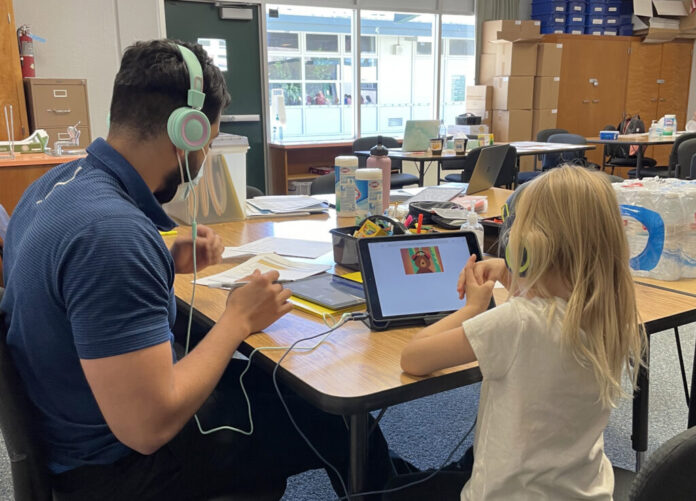
Many of the screeners are done one-to-one and last about 10 minutes.
Courtesy of UCSF Dyslexia Center
A 2023 California law requires all students in kindergarten, first and second grade to be screened for risk of reading difficulties, including dyslexia.
Here are some of the things teachers, principals and parents need to know.
Who must be screened?
All children enrolled in kindergarten, first and second grade must be screened once during the 2025-26 school year and every year thereafter while they are enrolled in these three grade levels.
However, students will not be screened if their parents or guardians opt out.
Students can also be exempted from the screening if they have a diagnosis of a reading difficulty, reading disorder, or other reading disability, or if they receive special education services, and their parent or guardian agrees.
In addition, students who do not speak sufficient English or Spanish should not be screened and instead should be evaluated in other ways.
What is the purpose of screening students?
The purpose is to see if students are at risk of developing reading difficulties, including dyslexia, if they don’t get support. Screenings are meant to help teachers understand better what they need to work on in class and what parents can work on at home so that children get the help they need to learn how to read at a young age.
What screeners are being used?
School districts had to choose one or more of four screeners available. You can read more about them here:
What do the screeners measure?
The screeners measure several skills important for learning to read, such as:
- oral language skills — the ability to speak the language (English or Spanish)
- knowledge of letter names
- phonological and phonemic awareness — knowledge of the sounds letters make alone and together with other letters
- decoding skills — the ability to sound out words
- rapid automatized naming — rapidly naming pictures or letters in a row
- visual attention
- reading fluency — reading easily without stopping
- vocabulary
- language comprehension
How will parents know the results of the screening?
Schools are required to give parents or guardians the results of the screening and information about what they mean no more than 45 days after it was administered. In addition, the school should give parents information about any support the school will provide to the student to help them with the specific needs identified.
If a child is flagged for being at risk for reading difficulty, does it mean they have dyslexia?
No. If a child is flagged, it simply means that the child is at risk of developing reading difficulties in the future if they do not receive support. They may need additional instruction in one or more specific areas of reading — for example, they may need more instruction about the sounds letters make or more vocabulary.
Only after a student receives appropriate instruction targeted to their needs and still does not improve over time, then a school may consider whether a student needs an assessment by a professional to see whether they may have dyslexia or another disability.
When should students be screened?
The law says that school districts can screen children at any time of the school year, but that they should consider whether students have received sufficient instruction in foundational reading skills.
The researchers at the UCSF Dyslexia Center recommend that to get the most accurate results, students in kindergarten should not be screened until they have had at least six to eight weeks of instruction, and that first and second graders should not be screened until at least four to six weeks into the school year.
If a student enrolls for the first time in the middle of the school year after the screening has already been administered to other students, the law states that the school has 45 days to screen the student.
How should multilingual students be screened?
Schools are required to check if a student speaks sufficient English to be screened with an English-language screener before administering it. If a student does not speak sufficient English, the school is supposed to screen them in their primary language if available. Currently, screeners are only available in Spanish and English.
If a student speaks Spanish at home and is learning English at school, experts recommend that they be screened in both languages, since they may have some knowledge of each.
If a student does not speak English or Spanish but a different language, schools are expected to evaluate their risk of reading difficulties by analyzing their developmental history, educational history and literacy progress, taking into account their proficiency in English.
What should schools do if a student is identified as at risk of reading difficulties?
If a student is identified as at risk of reading difficulties, the school should provide support and services based on the specific challenges identified. These supports and services might include evidence-based literacy instruction focused on the specific needs identified by the screener, monitoring the student’s progress, early intervention within the general education program, one-on-one or small group tutoring, or further evaluation.
The results are not supposed to be used for identifying whether a student needs special education, for keeping a child back a grade or skipping a grade, reclassifying English learners as proficient in English or evaluating teachers.






